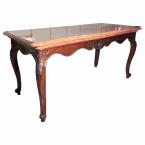


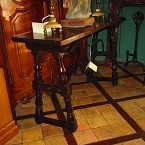


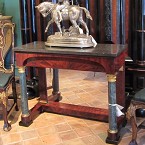
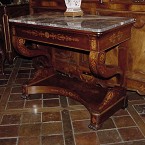


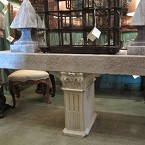
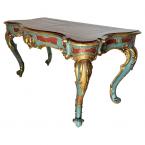


Height: 31.5 in. (80.01 cm)Width: 67.5 in. (171.45 cm)Depth:
31 in. (78.74 cm)
An exceptional large 18th century Louis XV chateau table
console "Table a Gibier", circa 1760. With original carved marble top
and all original elements. This beautiful table can serve as a console in an
entryway, to place a bust and lamps. The furniture of the Louis XV period
(1715-1774) is characterized by curved forms, lightness, comfort and asymmetry;
it replaced the more formal, boxlike and massive furniture of the Style Louis
XIV. From 1730 until about 1750, the period known as the first style, it was
much more asymmetrical, ornate and exuberant, in the fashion called rocaille.
From circa 1750 to the King's death in 1774, a reaction set in against the
excesses of the rocaille. The Second Style of Louis XV showed the influences of
Neoclassicism Betwewen 1755 and 1760, the forms of furniture and interior
decoration began to change into what became known as the Second Style Louis XV,
or the Style Transition. The rocaille decoration remained, but became more
discreet and restrained.

19th C. Dresser Ormolu Burl Elm Toilette Table Jacob
Desmalter JACOB D.R.MESLE . Early 19th
Century Empire Ormolu Mounted Burl Elm
“Table de Toilette” Estampille: Stamped: Jacob Desmalter et Cie. JACOB D.R.MESLEE
1803-1813
The Wooden Panel on the Reverse Side of Mirror bears the
following Inscription in faded black Ink: “Napoleon I, Empereur des Francais a
sa Belle Soeur La Reine De Westphalie, Paris 1808” Translation: From Napoleon
I, French Emperor to his sister in law the Queen of Westphalia, Paris 1808.
A Large Front Drawer with Hidden Compartment, and with Carved
wood stoppers. Key still present. The Bronze work is outstanding as expected.
The pictures speak for itself. With Two Pullout Side Drawers. Marble Of the
period with signs of hair cracks , hand carved , overall good condition. Losses,
Cracks and signs of age on the original glass. You are welcome to send you
professional to see it and inspect in person, to create a report.
During the reign of Jerome Bonaparte in Westphalia a French
architect and pupil of Percier, Grandjean de Montigny, re-furnished the castle
of Kassel and the Palace known as Wilhelmshöhe , then temporarily known as
Napoleonshöhe. Some of the furniture for these magnificent rooms was
commissioned from Jacob-Desmalter.
Jacob-Desmalter was the son of Georges Jacob and was
Christened François-Honoré-Georges Jacob-Desmalter (1770–1841). He took the
name Desmalter from a family property. He received the best training possible
in his father’s workshop, which he took over on his father’s retirement and ran
until 1835.
Queen consort Katharina of Württemberg ( Princess Friederike
Katharina Sophie Dorothea) was Queen consort of
Westphalia by marriage to Jérôme Bonaparte “Napoleon's younger brother” , who
reigned as King of Westphalia between 1807 and 1813.
Katharina was born in Saint Petersburg, Russian Empire, to
the later King Frederick I of Württemberg and his first wife, Duchess Augusta
of Brunswick-Wolfenbüttel. Her mother, who died when Katharina was five years
old, was a sister of Caroline of Brunswick and a niece of King George III of
the United Kingdom. After the death of Katharina's mother, her father married
Charlotte, Princess Royal, eldest
daughter of George III and thus a first cousin of his first wife.
In 1803, Württemberg entered into an alliance with France
under Emperor Napoleon I, and one of the terms of the treaty was the marriage
of Katharina with Jérôme Bonaparte, Napoleon's younger brother. The wedding was
held four years later, on 22 August 1807, at the Royal Palace of Fontainebleau
in France.
Upon marriage, Katharina became Queen consort of the Kingdom
of Westphalia. Reportedly, Katharina and Jérôme bonded strongly and had a happy
marriage, remaining firmly attached to each other.
When the kingdom of Westphalia was dissolved in 1813, she
followed Jerome to France. During the war, she and Désirée Clary took refuge
with Julie Clary at Mortefontaine, and when the allied troops took Paris, they
took refuge in the home of Desirée Clary in the capital.
Height: 64” Width:
34” Depth: 21”

Ornate and exuberant decoration , in the fashion called
rocaille with an abundance of curves , counter-curves , undulations and
elements modeled in nature . Even though The rocaille decoration is apparent
yet it shows more discreet and restrained on this incredible table, simply due
to the good taste and the sensitivity of the carver and the colorist who worked
on it . Giltwood with red and Soft blue
green colors hand painted . Antique Dealer West Hollywood Melrose Ave La
Cienega Blvd . The Colors of this Console Table are outstanding and original Exquisitely
detailed with various cartouches ,Foliage with all Four elegant cabriole legs
adorned with an abundance of rocailles motifs . No need to be connected to a
wall since it could be free standing . Graceful and Majestic silhouette with beautiful
patina . As a focal point in a Modern Midcentury Home or Old world Charm, this
table is very versatile. If one to use it as a free standing desk, we know
artists that could work on the “ Trompe l'oeil “
It's the perfect Console
for a grand bedroom or a great library or a foyer . this type of furniture were
made for a palazzo and grand Villa . Venice, Italian Venezia city, major
seaport , and capital of both the provincia (province) of Venezia and the
regione (region) of Veneto, northern Italy. An island city, it was once the
centre of a maritime republic. It was the greatest seaport in late medieval
Europe and the continent’s commercial and cultural link with Asia. Venice is
unique architecturally and historically and in its days as a republic the city
was styled la serenissima (“the most serene” or “sublime”). The luminous
spectacle of ornate marbled and frescoed palaces and domes reflected in the
sparkling waters of the lagoon under a blue Adriatic sky has been painted and imitated
in the furniture and art .











